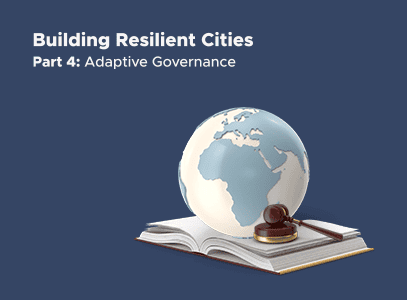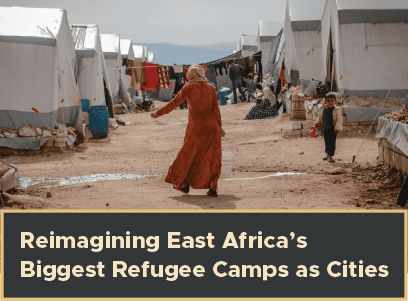Informal settlements are often depicted as shantytowns. However, informal settlements in Cairo tend not to fit this stereotype. The image below shows an informal settlement in the middle of Cairo. Unlike the typical settlement that features shacks built from wood, metal sheets, and tarps, this settlement consists of multistory apartment blocks made of brick and concrete. Multistory apartment blocks might not be expected to house informal settlements—building them is capital intensive and insecure land titling discourages investment.

In fact, most informal settlements in Cairo lack tenure security. However, they do not lack supporting infrastructure and are constructed under a developer-built model, not an owner-built model. Developers entering the informal housing market is a unique component of Egypt’s informal settlements, the end result of a mix of housing policies going back decades.
As Egypt has urbanized, informal housing has vastly outgrown formal development. An estimated 17 million people lived in well over 1,100 informal settlements, as of 2011. Notably, informal settlements do not only house lower-income residents— a broad spectrum of socio-economic classes reside in informal housing.
Starting in the late 1970s, the Egyptian government began promoting the development of new town projects to help house the rapidly urbanizing population. However, the new towns ultimately failed to achieve their principal objectives. They were not affordable for the lower and lower-middle classes and were located far from most employment opportunities, as they were only accessible by private car.
These units were developed under a “for sale” model, excluding would-be renters from the market. Egypt’s rent control laws (1944-1996) discouraged investment in rental properties and kept thousands of potential housing units out of the market. Restrictive building regulations further precluded the development of affordable formal housing accessible to low- and middle-income Egyptians.
After the new towns, the Egyptian housing market liberalized, attracting private developers to the housing market. However, much of the new construction consisted of luxury units targeting upper-middle and high-income Egyptians returning from the Gulf States with money to invest. Rising land prices combined with strong regulation continued to discourage the creation of a housing market accessible to the masses.
The lack of formal housing for new urban residents led to the creation informal settlements, which have grown rapidly since the 1960s. The approach of the Egyptian government towards informal settlements was often arbitrary, and at times contradictory. In some cases, the government tolerated informal building, passing various laws granting amnesty and recognition to inhabitants. At the same time, laws were also passed limiting the growth of settlements by imposing fines and jail time for informal builders. Despite these restrictions, informal settlements continued to grow.
From 1950 through the 1990s. the Egyptian government slowly incorporated informal settlements into the cities and extended limited infrastructure like community water taps. The settlements grew as residents utilized what infrastructure was available, while bootlegging electricity and septic tanks that were emptied weekly. The infrastructure extensions remained incremental and quite limited until the 1990s when the government began to fear the emergence of radical Islamist groups in the settlements. After the 1992 earthquake, these groups played an important role in helping residents recover, and so the government responded by creating the legal frameworks to provide electricity, water, and sanitation to informal buildings, even though the buildings were still technically illegal.
Informal residents flooded the water and electricity companies with requests for infrastructure connections, as per the new laws. An electricity connection also gave the occupant an official document from the government with the their name and address, which some residents later used to fight for tenure security. Electricity meters created a paper trail connecting the owner to the property, creating formal infrastructure inside of informal buildings.
By now, Cairo’s informal settlements have existed comfortably for decades and the recent infrastructure provision has provided residents with greater stability and a new degree of formality. This development led to a paradigm shift in the way the informal settlements were being developed, shifting the building process from an owner-built incremental approach by marginalized individuals to a proper real estate market with developers having enough capital to flip properties and land for profit.
By the end of the 1990s, Cairo’s informal settlements had almost universal access to infrastructure and the high-rise settlements began to appear. Those high-rises are well located in Cairo’s inner fringe and can reach 10-20 floors. Unlike incrementally built settlements, these high-rises are typically built to completion before units go on the market. The high-rise settlements were only a small share of Egypt’s informal housing in the late 1990s, but have since grown to occupy a much larger share of the total informal market.
Whether through squatting on public-owned land or illegally subdividing agricultural land for housing, informal settlements occupied prime locations in Cairo. As Cairo’s population grew, so did the demand for more units in these locations. The new units attracted new residents, who could afford to buy or rent an already built unit with complete access to infrastructure in a prime location with a price much lower than a comparable unit in the formal market.
High-rise settlements helped house millions of people closer to work opportunities, and infrastructure helped provide relatively decent living standards. Despite the opportunities afforded by the high-rise settlements, in some cases streets designed for two-story buildings were occupied by 10-20 story buildings, limiting privacy, ventilation, and sunlight for some properties.
The high-rise informal settlements in Cairo are a unique phenomenon, but their emergence should not come as a surprise. Semi-formal ownership recognition, infrastructure provision, and other legislation tolerant of the settlements, coupled with a growing demand for affordable housing, encouraged developers to enter the informal market and capitalize on this new opportunity.
Self-built housing is one option for low-income people in Egypt and worldwide. But the creation of Cairo’s high-rise settlements is clear evidence of the market potential for developers, if government can provide the necessary legal and physical infrastructure. With the right policies, the growth of informal settlements can be channeled towards the formal sector, as was done in Cairo.







